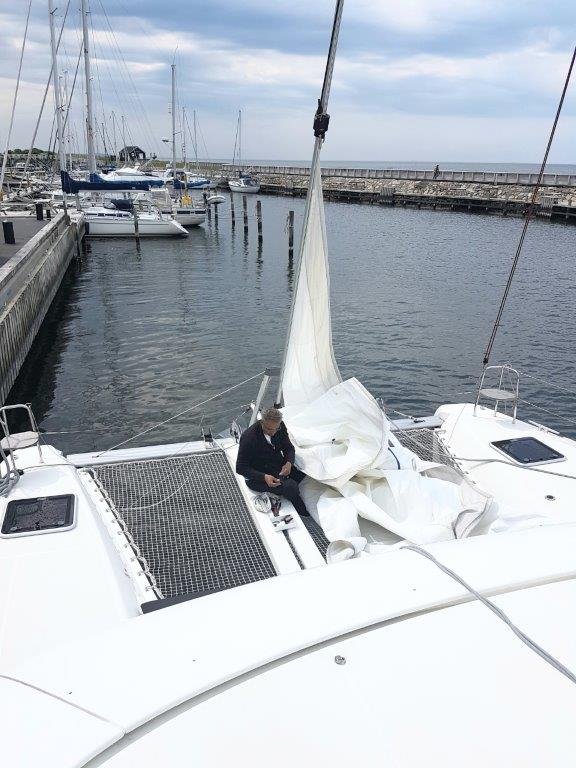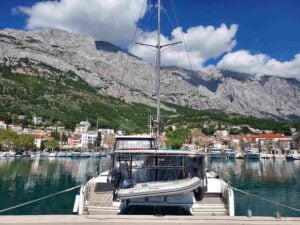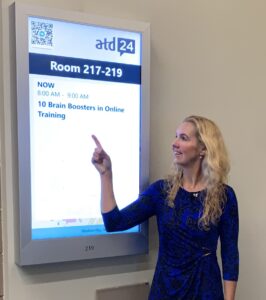‘Anything that can break on your ship, will break’. That was not a very uplifting remark, a sailor made to me during our conversation! I interviewed 10 sailors in 2020, who had sailed the world seas, in preparation for our catamaran world trip. This sailor made it very clear: ‘the salt water of the seas will get everywhere on your ship. Think of anything you never imagined it would break, it will get broken. Salt is unforgiving’. And he was right! We have been sailing now for 38 weeks and almost every week we have had a (small) repair on the boat.
Sometimes the damage is caused by salt water or strong winds. The forces of nature. But to be honest, most of the time, it’s our own fault, the damage is caused by our inattention or laziness.
So if you think our life on board is carefree, lounging all day on our sundeck. You are wrong.
Even living in this dream’house’, you are not exempt from doing maintenance on your house. In fact, our house is permanent on the water, bad maintenance can cost you your life: you will sink, crash or get injuries.
So far the dramatic words 😊. It just means, check your ship and parts regularly and do your repairs, because it will fire back at you right away if you neglect broken parts. When you need them in an emergency situation when sailing, you cannot count on them anymore.
There is a famous saying among sailors: ‘if you don’t schedule time for maintenance, your equipment will schedule it for you’.
All these sailor’s quotes are very true we found out! Since we have started sailing on the 1st of Mai 2021, we are on the way for 38 weeks and literally every week we have a repair. So 38 repairs done to our boat. At least. Many small, some large.
We selected 10 repairs to share, because these give a good idea of what you can expect when it comes to maintenance on a sailboat. We are lucky that Gilles has a technical background and I am a practical person, so we can do a lot of repairs ourselves, but in some cases we had to hire outside expertise to do the repairs.
- Code Zero
What happened: in Denmark we sailed the westcoast. One day, it was quiet weather and we put our biggest sail up (100 square meter), called the Code Zero. It’s a sail made of thin material, used during downwind, up to 66 degrees and a maximum of 18 knots of wind. We arrived at a harbor after a long day of sailing, we wanted to stay in this harbor for a few days, so we rolled up the Code Zero, in order to take it down the next day and put it in our storage, because it would get more windy. During the night the wind already picked up and the Code Zero unrolled itself and a piece of about 4 meters long was sticking out and was torn to pieces during the windblows in the night. We only discovered this the next morning, when it was too late.
How was it fixed: you can buy a new sail, but that’s expensive and the sail was only 1,5 years old. Our creative idea was to go to a sailmaker and ask her to put an extra band of 50 cm of sail along the entire edge of 22 meters. So now we have a sail, that has a colorful red and grey stripe on one side and it actually looks more funky that the 100% light brown color of the ‘old’ code zero.
2. Winche
What happened: due to the salty water, the lines on deck become rough. Also the line to pull our jib in and out. We use winches on board to do a lot of the work, and this time a winche was turning very stiffly to take the jib in. The line got tighter around the winche and all of a sudden the winche was messed up. The turning of the winche stopped, the plastic parts broke and the stainless steel parts inside, like the bolts, were bent.
How was it fixed: we bought new parts and installed them ourselves in the winche and we straightened the bent top plate with hammer and chisel, so the complete winche worked again
3, Door lock
What happened: this is a good example of how salt works! When we sail, sometimes small waves of seawater get on deck. Usually only a few meters and then it floats away again. But salt also gets in the air, living on board and it whirls down on your ship. On our boat, we have an outside seatingarea and then a sliding door with a lock to go inside the boat. One day, we closed the sliding door, and the lock fell down inside the door. Just like that. After 6 months of being in the salty air, not even getting in touch with seawater, the lock became a victim of corrosion!
How was it fixed: The broken part of the lock was a small metal spring which looked like the little ring to open a can of soda. We found that out by pulling the lock up with a strong magnet on the outside of the door. Otherwise we never have gotten the lock up or out! After that finding, we opened a coke can and adapted the little ring to fix the lock temporarily. Then we bought in a hardware store a stainless steel spring to install in the lock (we actually bought 3 springs, stock is always good!).
4. Jib sail
What happened: the jib rim scrapes along a part of the rigging of the boat when we have to do a lot of tacking (rigging are the ‘iron’ lines to keep for instance the mast upright). We found that out too late, already a piece of the rim of the jib was worn out.
How was it fixed: we took the jib down and put a white piece of sail (a patch) upon the worn out part and fixed it. We also used dacron repair tape to improve the original situation. We now also look more carefully if the sails are not touching other objects when they are blowing in the wind.
5. Fishing nets
What happened: when sailing along the coast of the North Sea, in this case the west coast of Sweden, you always have to look for ‘fisher’s balls’. Fisherman put fishnets and lobsterpots on the bottom of the shallow North sea, to catch hering, cod, lobster or shellfish. The small orange or yellow balls floating on the surface of the water tell that there is a fishnet below the surface. Good to know for the fisherman, when he returns the next day to pick up his catch. But also for boats to avoid sail close to those balls, because a fishingnet in the rotating propellors of the boat can also mess up the engine! So we always have to keep an eye out for the fisher’s balls on the surface of the water. But of course, during 8 months of sailing, you will miss one….So during one day of sailing (not motoring, luckily!), we all of a sudden slowed down from 8 knots to 2 knots. What could have caused that to happen? We looked at our sails, there was still a lot of wind. And then we looked around, behind us and we saw that we lugged along some fisher’s balls….
How was it fixed: we immediately turned the boat with her nose into the wind, so there was no more force on the sails to keep on going. We laid still and with a knife started cutting of the lines of the fishing nets at the rear of our boat. It was a tough job, because it was a large net and also some lobster pots were attached. It came off, but there still might be a rope wrapped around the propellor of the starboard engine. When entering the harbor, both our engines had to be turned on in order to get the boat safely to the quay (catamarans usually don’t have bow thursters). We noticed that the starboard engine did not gave a lot of power, so there was still rope wrapped around the propellors. Gilles dove into the water and cut of the remaining parts of the rope. No damage luckily to the propellor and the engine.
6. Lazy bag
What happened: the lazy bag takes in the main sail when it comes down. It’s also a place to keep the sail dry and stored while you are in the harbor. The fabric of the lazy bag is made of a waterproof material called Sunbrella, but the scrubbing of the bag made a couple of stitches snap during the first months of sailing.
How was it fixed: With a thick needle and a thick white thread, we made a continuous stitching again on 2 sides of the lazy bag. It’s a tough job and you have to wear a special leather glove to push the needle in the cloth and use a pair of pliers to get it through the fabric! It were 2 small pieces of 15 cm of stitching, but it took us 2 times 1 hour to do.
7. Mast step
What happened: to rearrange the main sail, once it drops in the lazy bag, you have to climb up on the roof of the boat. On the mast, there are a few steps attached, so the climbing up the roof is more easy. The mast steps are ment to climb up the mast, but they also help you the first 1,5 meter to get up to the roof. During a sail, when the wind came from all directions, we rolled up the jib and noticed in the end, the line was getting really tight. It turned out, the line was wrapped around the projecting mast step and snapped it off. We didn’t notice that until the next sail, when I wanted to use the mast step to climb up the roof and saw the first step was missing. And 10 meters away, laying on the deck, we discovered the broken step!
How was it fixed: we ordered a new mast step, unscrewed the old one and installed the new mast step.
8. Bowsprit
What happened: the bowsprit is attached to the boat with 4 elastic lines to keep the bowsprit moving flexible with all the bouncing up and down on the waves. But everytime the elastic lines stretch, they also start to ‘crack’ a little bit. After 8 months we noticed the bowsprit moving very much up and down: the elastic lines became too flexible.
How was it fixed: we attached 2 spinners next to the elastic lines to relieve them a little bit when absorbing all the blows on the bow. We connected 2 tie wraps around all the spinners and elastic lines to keep them attached. And we bought a new stronger elastic line to replace the spinners and the worn out old elastic lines.
9. Dish washer
What happened: we have a dish washer installed in our outside seating area. It’s placed in a corner, sheltered from the all destroying salty seawater. But not from rainwater dripping in, we found out! So one morning, after a rainy night, we read error code 15 on the dish washer: the ‘acqua stop’ was activated and the dishwasher would not start.
How was it fixed: The installer had glued the outside of the dishwater with Sikaflex to the polyester surface of the boat. We had to use stanley knives to pry off the steal rims of the dishwasher. It took 4 hours to do so, but then we could slide out the dishwasher. We drilled a small hole in the bottom plate of the dishwasher, so any future (rain)water would not activate the styrofoam floater (aqua stop), but would be transported out of the bottom of the boat by the bildgepump closeby.
10. Plastic window in tent
What happened: in autumn and winter, we use a tent to protect our outside seating area on the boat and also to stay more sheltered ourselves when standing behind the steeringwheel. When we work with the sails, we often use the winches, but they are ‘inside’ the tent and the lines of sails are outside the tent. So we have to open ‘the little windows’ that are made in the plastic tent to make room for the lines to go around the winches. One time, we did not zip the window completely open and the line rubbed the plastic, and it took only 30 seconds of rubbing to burn a hole in the plastic window.
How was it fixed: we went to several sailshops and hardware stores to find a piece of thick plastic (1 square meter only) to sew into our tent. We couldn’t find it. Also not in garden stores, where we love to shop for sail necessities, because in the camping area you can get similar accessories that you also need on a sailboat! In the harbor of Edinburgh, we found a sailmaker (‘The Sail Doctor’, great name!) and they put in a new small window in our tent to make it ‘whole’ again!










